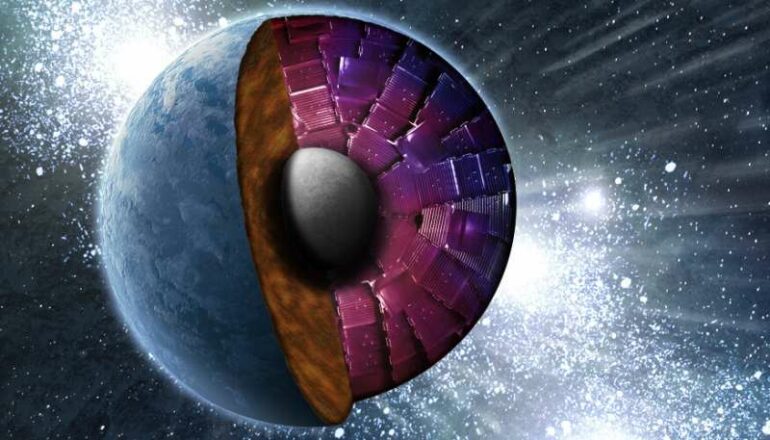The discovery of more than 4,500 extra-solar planets has created a need for modelling their interior structure and dynamics. As it turns out, iron plays a key role.
Lawrence Livermore National Laboratory (LLNL) scientists and collaborators have used lasers at the National Ignition Facility to experimentally determine the high-pressure melting curve and structural properties of pure iron up to 1,000 GPa (nearly 10,000,000 atmospheres), three times the pressure of Earth’s inner core and nearly four times greater pressure than any previous experiments. The research appears in Science.
The team performed a series of experiments that emulate the conditions observed by a parcel of iron descending toward the center of a super-Earth core. The experiments were allocated as part of the NIF Discovery Science program, which is open access and available to all researchers.
“The sheer wealth of iron within rocky planet interiors makes it necessary to understand the properties and response of iron at the extreme conditions deep within the cores of more massive Earth-like planets,” said Rick Kraus, LLNL physicist and lead author of the paper. “The iron melting curve is critical to understanding the internal structure, thermal evolution, as well as the potential for dynamo-generated magnetospheres.”
A magnetosphere is believed to be an important component of habitable terrestrial planets, like it is on Earth. Earth’s magnetodynamo is generated in the convecting liquid iron outer core surrounding the solid iron inner core and is powered by the latent heat released during solidification of the iron.
With the prominence of iron in terrestrial planets, accurate and precise physical properties at extreme pressure and temperatures are required to predict what is happening within their interiors. A first-order property of iron is the melting point, which is still debated for the conditions of Earth’s interior. The melt curve is the largest rheological transition a material can undergo, from a material with strength to one without. It is where a solid turns to a liquid, and the temperature depends on the pressure of the iron.
Through the experiments, the team determined the length of dynamo action during core solidification to the hexagonal close-packed structure within super-Earth exoplanets.
“We find that terrestrial exoplanets with four to six times Earth’s mass will have the longest dynamos, which provide important shielding against cosmic radiation,” Kraus said.
Kraus said: “Beyond our interest in understanding the habitability of exoplanets, the technique we’ve developed for iron will be applied to more programmatically relevant materials in the future,” including the Stockpile Stewardship Program.
The melt curve is an incredibly sensitive constraint on an equation of state model.
The team also obtained evidence that the kinetics of solidification at such extreme conditions are fast, taking only nanoseconds to transition from a liquid to a solid, allowing the team to observe the equilibrium phase boundary. “This experimental insight is improving our modeling of the time-dependent material response for all materials,” Kraus said.
Other Livermore team members include Suzanne Ali, Jon Belof, Lorin Benedict, Joel Bernier, Dave Braun, Federica Coppari, Dayne Fratanduono, Sebastien Hamel, Andy Krygier, Amy Lazicki, James McNaney, Marius Millot, Philip Myint, Dane M. Sterbentz, Damian Swift, Chris Wehrenberg and Jon Eggert. Researchers from the University of Illinois at Chicago, the Carnegie Institution for Science, University of Rochester, Sandia National Laboratory, California Institute of Technology, University of California Davis and University of California Los Angeles also contributed to the study.
More information:
Richard G. Kraus, Measuring the Melting Curve of Iron at Super-Earth Core Conditions, Science (2022). DOI: 10.1126/science.abm1472. www.science.org/doi/10.1126/science.abm1472
Provided by
Lawrence Livermore National Laboratory
Citation:
Ironing out the interiors of exoplanets (2022, January 14)



